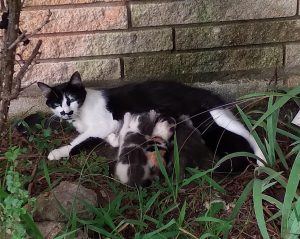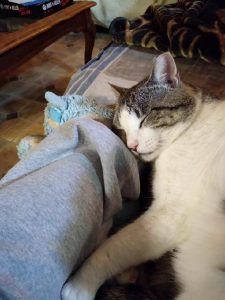What if the cant won’t go in the trap?
You’re bound to run across a cat that just doesn’t want to cooperate. In those cases, you have to think like a cat!
Fact: Cats like routines, so having a trap invade their space can be upsetting.
Solutions:
- In the perfect world, you would introduce the trap to the cat prior to trapping. Let the trap sit in its trapping place several days prior to trapping so in essence the cat sees it as a piece of furniture.
- Train cat to gradually go further and further into the trap by using a bungee cord to hold the front door open. On the first day place the food just inside the door. Each subsequent day move the food further and further back until it’s at the very back of the trap. Once it’s used to eating from the very back of the trap, remove bungee cord.
- If an introductory period is not feasible, at least when you go to trap put it in/near the area where kitty is used to eating.
Fact: Cats are not inclined to go waltzing into a trap—even if it has food in it—unless they are REALLY hungry.
Solution: Withhold food prior to trapping. Example: If you’re tapping in the late afternoon/early evening, give the cat a “continental breakfast” in the morning (feed lightly). Except for the small amount of food trail you place in the trap, do not feed again until after the cat is in the trap.
Fact: Cats like hidey spots and might not be thrilled at the prospect of walking into a trap out in the middle of an open space.
Solution: Cover the trap with sheet or towel and move trap near a wall, bush, parked car (that you know will not be moved during the trapping process!), etc.
Fact: Your cat can be a finicky eater and might not want the food in the trap.
Solution: Switch up the bait in the trap. Kitty SURELY likes something. Possibilities include but are not limited to tuna, salmon, mackerel, sardines, chicken, ham, turkey, beef, or even dry food. (Yes, believe it or not, some cats don’t like meat, so try dry cat food.)
Fact: Cats like to think everything is their idea, not yours
Solution: Do not coax the cat into the trap. Bait the trap, set it, and walk away—preferably where the cat cannot see you but you can monitor the trap.
Fact: As docile as Little Precious Cat might be, a cat’s personality can change if it thinks you’re going to pick it up and put him/her in a trap.
Solution: Give the trapping process a chance and avoid picking up Little Precious who might just turn into Crazy Cat if you attempt to place it in the trap. If you are absolutely convinced placing the cat in the trap is better than trying to lure it into the trap with food, you can either:
- Open the trap door and scoot the cat in. Unless the cat is EXTREMELY docile, this rarely works!! So try a bolder move.
- Make sure the rear door’s latch is securely fastened to the stationary bar of the trap. Turn the trap so it is vertical with the back door on the ground, open the entrance door (the one with the rings), scruff the cat, and place the cat in the trap back feet first. Close the door, secure the door (using a carabiner clip or gear tie, for example), then carefully lower the trap to the ground.
Fact: Cats, with rare exception, are not happy campers to discover they’ve been trapped.
Solution: Once the cat is trapped, drape trap with a cloth ASAP. (Do not run toward the trap with the cover, but instead walk briskly.) Within 30 seconds or so the cat will have calmed down considerably.
Fact: People think the trapped cat is hungry and sometimes are tempted to try to feed the trapped cat. (After all, you withheld food so it has to be starving, right? Wrong!)
Solution: Do not attempt to feed the cat! If you attempt to put food in the trap (1) the cat might try to escape and/or (2) you might get mauled. Trapped cats are stressed out and rarely want to eat. Usually, their first attempt to eat is after their surgery. So just make sure both doors are secured shut, cover the trap and set it in a safe place out of inclement weather, then call your Fayette Humane Society contact person. More than likely they will overnight the cat and will be able to feed it up until midnight using the proper safeguards to prevent an escape.
[return to top]




 p her babies and play with them, so I decided then that once the kittens were old enough to be away from Mom, we would find homes for them, and get Oreo fixed. We found homes for three of the kittens, and the first two were picked up by their new owners. Two days before the third one was going to go to his new home, a dog came into the yard and killed him, and the fourth kitten was nowhere to be found. We were devastated.
p her babies and play with them, so I decided then that once the kittens were old enough to be away from Mom, we would find homes for them, and get Oreo fixed. We found homes for three of the kittens, and the first two were picked up by their new owners. Two days before the third one was going to go to his new home, a dog came into the yard and killed him, and the fourth kitten was nowhere to be found. We were devastated. lady named Mrs. Marcia came out. She caught Oreo right then and there in our driveway. She left two more traps, and we caught two more cats. One was the daddy to the kittens who we had named The Silver Fox. She took them to the clinic to get them fixed, and brought them back to our yard.
lady named Mrs. Marcia came out. She caught Oreo right then and there in our driveway. She left two more traps, and we caught two more cats. One was the daddy to the kittens who we had named The Silver Fox. She took them to the clinic to get them fixed, and brought them back to our yard. because he had always run from us when we approached him. Well, I should have not doubted her. After a few weeks, he began to greet me when I would get home from work. He would rub on my legs, meow at me, and roll over onto his back to get belly rubs. I couldn’t believe it! This cat that we thought was feral was as tame and loving as any cat I had ever seen. When the temperature dropped into the twenties, my husband decided to bring him inside. Needless to say, he is our cat now!
because he had always run from us when we approached him. Well, I should have not doubted her. After a few weeks, he began to greet me when I would get home from work. He would rub on my legs, meow at me, and roll over onto his back to get belly rubs. I couldn’t believe it! This cat that we thought was feral was as tame and loving as any cat I had ever seen. When the temperature dropped into the twenties, my husband decided to bring him inside. Needless to say, he is our cat now!